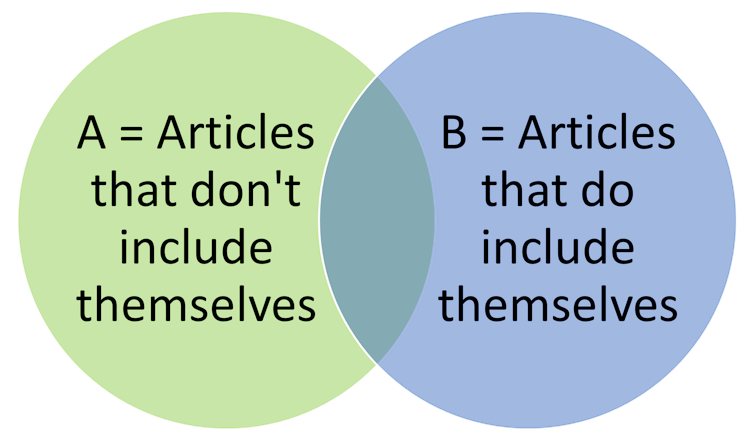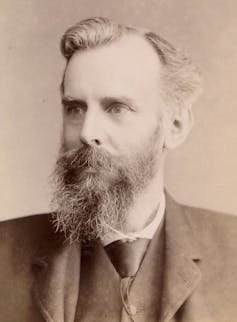April 2023 marks the 100th anniversary of the death of mathematician and philosopher John Venn. You may well be familiar with Venn diagrams – the ubiquitous pictures of typically two or three intersecting circles, illustrating the relationships between two or three collections of things.
For example, during the pandemic, Venn diagrams helped to illustrate symptoms of COVID-19 that are distinct from seasonal allergies. They are also often taught to school children and are typically part of the early curriculum for logic and databases in higher education.
John Venn. wikipedia, CC BY-SA
Venn was born in Hull, UK, in 1834. His early life in Hull was influenced by his father, an Anglican priest – it was expected John would follow in his footstep. He did initially begin a career in the Anglican church, but later moved into academia at the University of Cambridge.
One of Venn’s major achievements was to find a way to visualise a mathematical area called set theory. Set theory is an area of mathematics which can help to formally describe properties of collections of objects.
For example, we could have a set of cars, C. Within this set, there could be subsets such as the set of electric cars, E, the set of petrol based cars, say P, and the set of diesel powered cars, D. Given these, we can operate on them, for example, to apply car charges to the sets P and D, and a discount to the set E.
These sorts of operations form the basis of databases, as well as being used in many fundamental areas of science. Other major works of Venn’s include probability theory and symbolic logic. Venn had initially used diagrams developed by the Swiss mathematician Leonard Euler to show some relationships between sets, which he then developed into his famous Venn diagrams.
Venn used the diagrams to prove a form of logical statement known as a categorical syllogism. This can be used to model reasoning. Here’s an example: “All computers need power. All AI systems are computers.” We can chain these together to the conclusion that “all AI systems need power”.
Today, we are familiar with such reasoning to illustrate how different collections relate to each other. For example, the SmartArt tool in Microsoft products lets you create a Venn diagram to illustrate the relationships between different sets. In our earlier car example, we could have a diagram showing electric cars, E, and petrol powered cars, P. The set of hybrid cars that have a petrol engine would be in the intersection of P and E.
Logic and computing
The visualisation of sets (and databases) is helpful, but the importance of Venn’s work then – and now – is the way they allowed proof of George Boole’s ideas of logic as a formal science.
Venn used his diagrams to illustrate and explore such “symbolic logic” – defending and extending it. Symbolic logic underpins modern computing, and Boolean logic is a key part of the design of modern computer systems – making his work relevant today.
Venn’s work was also crucial to the work of philosopher Bertrand Russell, showing that there are problems that are unsolvable. We can express such problems with sets, in which each is an unsolvable problem. One such unsolvable problem can be expressed with the “Barber paradox”. Suppose we had an article in Wikipedia containing all the articles that don’t contain themselves – a set. Is this new article itself in that set?
Luckily we can visualise that with a Venn diagram with two circles, where one circle is the set of entries that don’t include themselves, A, and the other circle is the set of entries that do include themselves, B.
We can then ask the question: where do we put the article that contains all the articles that don’t contain themselves? Have a think about it, then see where you would put it.

A Venn diagram of two sets - a set A of articles that do contain themselves, and a set B of articles that don’t.
The problem is that it cannot be on the left, as it would contain itself, and would therefore be inconsistent. And it cannot be on the right, as then it would be missing, or incomplete. And it can’t be in both. It must be in one or the other. This paradox illustrates how unsolvable statements can arise – they are valid in terms of expressing them within the logical system, but ultimately unanswerable. We could possibly extend our system to solve this, but then we would end up with another unanswerable question.
Venn’s diagrams were crucial in understanding this. And this area of science is still important, for example when considering the limitations of machine learning and AI, where we may ask questions that cannot be answered.
Venn also had an interest in building mechanical machines – including a bowling machine which proved so effective it was able to bowl out some top Australian batsmen of the day.
Following his abstract work on logic, he developed the concept of a logical-diagram machine with a lot of processing power: though this brilliant idea from 1881 would take many decades to appear as modern computers.
We remember Venn here in Hull, with a bridge close to his birthplace decorated with Venn circle inspired artwork. At the University of Hull’s main administration building, there’s an intersection of management and academia which is called the Venn building.



 NASA Astronauts Wilmore and Williams Recover After Boeing Starliner Delay
NASA Astronauts Wilmore and Williams Recover After Boeing Starliner Delay  Astronomers have discovered another puzzling interstellar object − this third one is big, bright and fast
Astronomers have discovered another puzzling interstellar object − this third one is big, bright and fast  Trump Administration to Launch Autism Initiatives Targeting Acetaminophen Use and New Treatment Options
Trump Administration to Launch Autism Initiatives Targeting Acetaminophen Use and New Treatment Options  Cogent Biosciences Soars 120% on Breakthrough Phase 3 Results for Bezuclastinib in GIST Treatment
Cogent Biosciences Soars 120% on Breakthrough Phase 3 Results for Bezuclastinib in GIST Treatment  FDA Pilot Program Eases Rules for Nicotine Pouch Makers
FDA Pilot Program Eases Rules for Nicotine Pouch Makers  Lost in space: MethaneSat failed just as NZ was to take over mission control – here’s what we need to know now
Lost in space: MethaneSat failed just as NZ was to take over mission control – here’s what we need to know now  NASA and Roscosmos Chiefs Meet in Florida to Discuss Moon and ISS Cooperation
NASA and Roscosmos Chiefs Meet in Florida to Discuss Moon and ISS Cooperation  SpaceX’s Starship Completes 11th Test Flight, Paving Way for Moon and Mars Missions
SpaceX’s Starship Completes 11th Test Flight, Paving Way for Moon and Mars Missions  Trump Signs Executive Order to Boost AI Research in Childhood Cancer
Trump Signs Executive Order to Boost AI Research in Childhood Cancer  Ancient Mars may have had a carbon cycle − a new study suggests the red planet may have once been warmer, wetter and more favorable for life
Ancient Mars may have had a carbon cycle − a new study suggests the red planet may have once been warmer, wetter and more favorable for life  Trump and Merck KGaA Partner to Slash IVF Drug Costs and Expand Fertility Coverage
Trump and Merck KGaA Partner to Slash IVF Drug Costs and Expand Fertility Coverage  Eli Lilly’s Inluriyo Gains FDA Approval for Advanced Breast Cancer Treatment
Eli Lilly’s Inluriyo Gains FDA Approval for Advanced Breast Cancer Treatment 





























